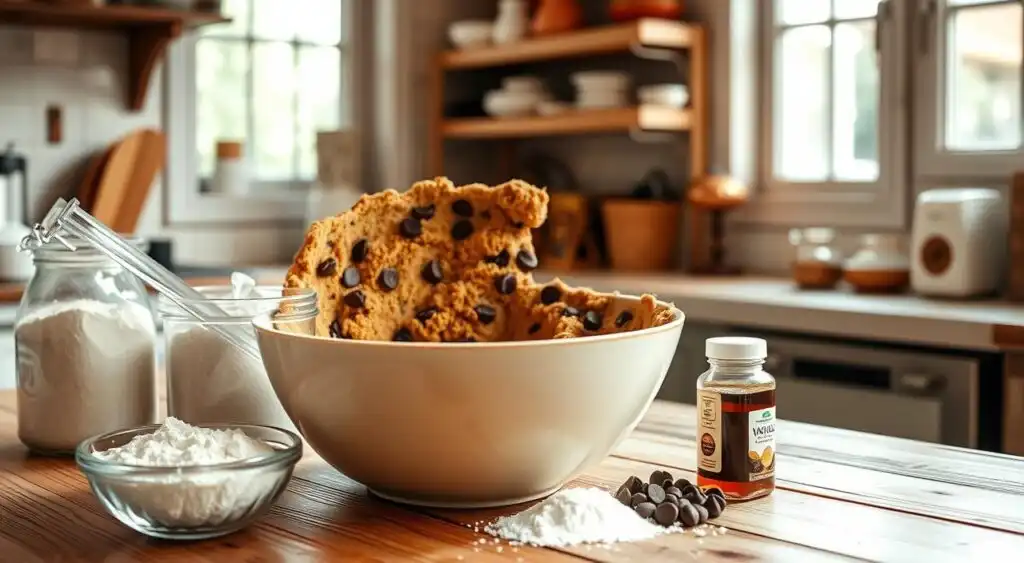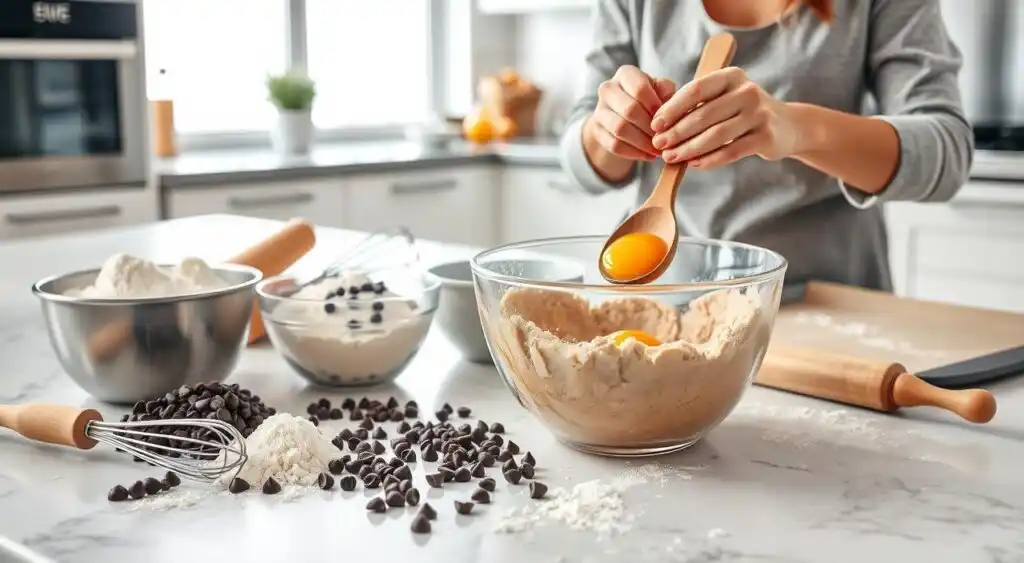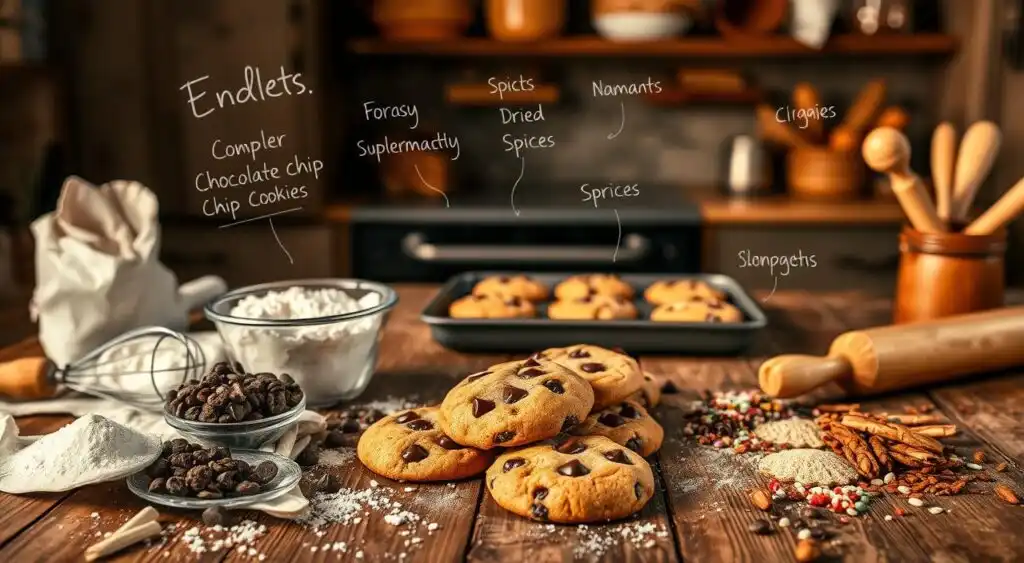There’s something magical about baking. It’s not just about mixing ingredients or following steps—it’s about creating memories. For me, it all started with my Nana’s cherished recipe, a treasure passed down through generations. That’s why I’m excited to share this twist on a classic: a chocolate chip cookie made without brown sugar.
You might wonder, “Does skipping this ingredient affect the taste or texture?” The answer is no. This version stays soft, chewy, and utterly delicious. Whether you’re out of brown sugar or want to try something new, this recipe is a winner.
Baking is more than a process it’s a way to bring joy to others. Imagine gifting these cookies in a beautiful dish or with a handwritten note. It’s the little details that make them special. Ready to get started? Let’s dive into this simple yet delightful baking adventure.
Table of Contents
Getting Started: Ingredients and Essential Tools
The foundation of any great treat lies in preparation. Before you begin, gather your essentials to ensure a smooth and enjoyable process. This section will guide you through the key ingredients and tools you’ll need to create something truly special.
Essential Ingredients and Substitutes for Perfect Chocolate Chip Cookies
High-quality ingredients are the foundation of any great chocolate chip cookie recipe. Using premium unsalted butter, for example, ensures that you have a rich, controllable flavor without the interference of extra salt. Granulated sugar (often abbreviated in recipes as “gra”) is essential for sweetening your dough and achieving that perfect, slightly crisp texture along the edges of your cookies. The delicate balance between granulated and brown sugars not only sweetens but also influences the spread and chewiness of your chocolate chip cookie.
Eggs play a vital role by binding the ingredients together and providing moisture, which contributes to a soft and tender crumb. Meanwhile, pure vanilla extract enriches the flavor profile, enhancing every bite of your chocolate chip cookie with its aromatic sweetness. All-purpose flour provides the necessary structure, ensuring that your cookies hold together while still remaining light and airy.
If you ever find yourself missing a key ingredient, there are plenty of substitutes to keep your cookie-making on track. For instance, if granulated sugar is low, you might consider using a mix of light brown sugar to maintain sweetness and moisture, though this may slightly alter the cookie’s texture. In place of eggs, a common substitute is unsweetened applesauce, which can lend a healthier twist without compromising the overall structure too much. Similarly, natural sweeteners like honey or maple syrup can replace some or all of the sugar, adding their unique flavors to your chocolate chip cookie.
For those looking to experiment further, some bakers add crushed graham crackers to the dough. This twist introduces a subtle crunch and a complementary flavor that enhances the classic chocolate chip cookie experience. Having these alternatives on hand means you can always adapt your recipe without sacrificing quality or taste.
By understanding the role of each ingredient and knowing your substitutes, you can master the art of baking perfect chocolate chip cookies every time.
Must-Have Kitchen Tools and Equipment
Accurate measuring tools are crucial. A kitchen scale ensures precision, while a cookie scoop helps create uniform portions. Mixing bowls and a baking sheet lined with parchment paper are essential for efficiency.
Don’t forget your oven! Preheating it to the right temperature ensures even baking. With these tools, you’ll be ready to confidently tackle any recipe.
Exploring the chocolate chip cookie recipe without brown sugar
Understanding the science behind baking can elevate your results. Every ingredient plays a role in shaping the final product, and sugar is no exception. In this section, we’ll dive into how sugar affects texture and flavor, and why this recipe works beautifully even without brown sugar.

The Role of Sugar in Cookie Texture and Flavor
Sugar isn’t just about sweetness it’s a key player in baking chemistry, especially when it comes to the beloved chocolate chip cookie. The type of sugar you use can dramatically influence both texture and flavor. For instance, brown sugar, enriched with molasses, not only imparts a deeper, caramel-like flavor but also adds moisture that leads to a chewy, soft center and a slightly crisp edge. On the other hand, granulated sugar, often referred to in recipes as the primary sweetener for its ability to create a tender interior and a lighter, crisper exterior, is crucial for achieving the desired balance in cookie texture.
When you combine these sugars, or even substitute one for the other, the result is a fascinating interplay between moisture retention and crispiness that defines a perfect chocolate chip cookie. This balance is a result of how sugar interacts with the fats and flour during mixing and baking. During the baking process, sugar melts and dissolves, contributing to the formation of air pockets that ultimately influence the cookie’s structure and spread. In a way, each type of sugar plays its part as a subtle architect of flavor and mouthfeel.
Why This Recipe Works Even Without Brown Sugar
Even without the distinctive taste of brown sugar, this recipe for chocolate chip cookie manages to impress. The secret lies in the careful calibration of ingredients and baking techniques that make the most out of granulated sugar. By using granulated sugar exclusively, you create a cookie that maintains an even spread and a crisp outer edge while still achieving a soft, tender interior. This method relies on precise mixing and temperature control to ensure that the dough holds together just right, preventing the cookies from becoming too thin or overly crunchy.
The clever formulation behind this recipe proves that a chocolate chip cookie doesn’t necessarily need the depth of flavor provided by brown sugar to be delicious. The balanced ratio of granulated sugar to butter and flour allows the natural sweetness to shine, enhanced by the melting of chocolate chips during baking. The end result is a cookie that is both visually appealing and satisfying to the taste combining the best of both worlds in texture and flavor.
Preparation Steps and Baking Process
Crafting the perfect chocolate chip cookie involves more than simply mixing ingredients it’s a process of art and precision. Start by creaming the granulated sugar and butter together until the mixture is light and fluffy. This step is vital as it incorporates air into the dough, which contributes to a tender, soft interior. Once the sugars are well-integrated, gradually add your eggs and vanilla extract, ensuring that each element is fully blended before introducing the dry ingredients.
When incorporating the flour, salt, and any leavening agents, mix just enough to combine them. Overmixing can lead to a tough cookie, while under-mixing might cause uneven texture. Once your dough is ready, fold in the chocolate chips evenly, so every bite carries the delightful burst of chocolate. Whether you choose to chill the dough for a few hours or bake immediately, paying attention to oven temperature and baking time is critical. A slightly higher temperature for a shorter time can yield a cookie that’s crisp on the edges yet soft and gooey in the center.
By meticulously following these steps, you harness the power of granulated sugar in crafting a chocolate chip cookie that perfectly marries crispness and chewiness—a testament to the intricate science of baking.

Merging Wet and Dry Ingredients
Begin by gently melting the butter over low heat until it’s completely liquefied. This careful approach is essential for a perfect chocolate chip cookie, as overheating the butter can cause it to separate and may inadvertently cook the eggs when they’re added later. Once the butter is melted, gradually whisk in the sugar until the mixture becomes pale, light, and fluffy. This process helps incorporate air into the batter, setting the stage for a tender texture that’s ideal for a delicious chocolate chip cookie.
Next, add the eggs one at a time, ensuring that each egg is fully incorporated before adding the next. This step helps maintain an even consistency, and it prevents the mixture from curdling. A splash of vanilla extract is added at this stage to enhance the overall flavor profile. Mix until the wet ingredients are just combined, being careful not to overwork the batter.
With your wet ingredients ready, slowly fold in the sifted dry ingredients: all-purpose flour, a pinch of salt, and a hint of baking soda. This gradual incorporation minimizes gluten formation, which is crucial for keeping your chocolate chip cookie light and soft rather than dense. For an extra twist, you might consider adding secondary ingredients such as a small amount of graham cracker crumbs. These crumbs can lend a subtle, crunchy texture and a rich, complementary flavor that pairs beautifully with the chocolate chips.
Finally, fold in your favorite mix-ins most notably, generous chunks of chocolate chips using a spatula. This folding technique ensures that the chocolate remains intact and evenly distributed throughout the batter, delivering a delightful burst of flavor in every bite of your chocolate chip cookie.
Baking Time and Temperature Guidelines
When making a classic chocolate chip cookie, achieving the perfect balance between a soft center and slightly crispy edges relies heavily on your baking time and temperature. Start by preheating your oven to 350°F (175°C) and lining a baking sheet with parchment paper for effortless cleanup. For consistent results, use a cookie scoop to portion out your dough, ensuring that each ball sits about 2 inches apart. This spacing is crucial, as it allows the cookies to spread evenly during baking.
Fine-Tuning Your Bake for the Perfect Chocolate Chip Cookie
While the standard baking time is 14-17 minutes, several factors can influence the final texture of your chocolate chip cookie. For instance:
- Pan Color & Material: Light-colored, insulated pans generally require the full 17 minutes to reach a deep, even golden-brown edge, whereas darker or non-insulated pans can conduct heat more rapidly, necessitating a slightly shorter baking time.
- Dough Consistency & Add-ins: Whether you’re adding extra ingredients like chopped nuts or even a twist with graham cracker crumbs (a creative secondary ingredient that can enhance texture and flavor), these additions might alter how quickly your cookies bake. If you’re using graham elements in your dough, keep an eye on them as they might accelerate browning.
- Oven Variations: No two ovens are exactly alike. It’s wise to start checking your chocolate chip cookies at the 14-minute mark, especially if your oven tends to run hot. The edges should be beautifully golden, while the center remains soft enough to create that irresistible chewy bite.
Cooling and Setting for Optimal Texture
Once your chocolate chip cookies are baked, allow them to rest on the baking sheet for a few minutes. This resting period helps the cookies set properly, ensuring they maintain their shape and achieve the desired texture. Transfer them to a wire rack to cool completely, which prevents them from becoming too crumbly and helps preserve their delightful balance of textures.
By adjusting your baking time and closely monitoring temperature, you can master the art of crafting the perfect chocolate chip cookie with or without additional graham-inspired twists. Enjoy experimenting and fine-tuning your recipe to create a cookie that’s uniquely yours!
Tips, Variations, and Customization Options
Customizing your baking creations can make them uniquely yours. Whether you’re adding a twist to the flavor or ensuring precise measurements, small changes can have a big impact. This section will guide you through creative additions and tips for consistent results.

Creative Additions for Enhanced Flavor
Adding mix-ins can elevate your treats. Try chopped nuts, dried fruits, or coconut flakes for extra texture and taste. A sprinkle of flaky sea salt on top adds a gourmet touch.
For a richer experience, reserve some chocolate chips to press into the dough balls before baking. This ensures a burst of flavor in every bite. Experiment with candy pieces or a drizzle of caramel for a fun twist.
Measuring Ingredients for Consistency
Precision is key in baking. Use a kitchen scale to measure flour and sugar accurately. This ensures the right texture and avoids overly dense or cake-like results.
Here’s a quick guide to ingredient substitutions:
| Ingredient | Substitute | Notes |
|---|---|---|
| Granulated Sugar | Honey or Maple Syrup | Adjust liquid ingredients slightly |
| Butter | Applesauce | For a healthier option |
| Baking Soda | Baking Powder | Use 2-3 times the amount |
Remember, small tweaks can dramatically change the texture. Keep your changes balanced to maintain the core delicious flavor. Customization is the key to making the recipe your own.
Conclusion
Creating something special in the kitchen doesn’t require complex ingredients or techniques. This recipe proves that even without traditional brown sugar, you can achieve a treat that’s both flavorful and satisfying. The right balance of ingredients and careful mixing ensures a soft interior with crisp edges.
Precision is key. Measure your flour and butter accurately to maintain the perfect texture. Experiment with mix-ins like nuts or dried fruits to make the recipe your own. Sharing these homemade delights with loved ones adds a heartfelt touch to any occasion.
With just a few simple steps, you can whip up a batch in under 30 minutes. Whether you’re short on ingredients or simply exploring new flavors, this method delivers consistent results. Enjoy the process, and savor the joy of baking something truly special.
** Similar meals that may interest you:
How to Make Perfect Biscuits and Gravy from Scratch
1 thought on “How to Make Chocolate Chip Cookies Recipe Without Brown Sugar”